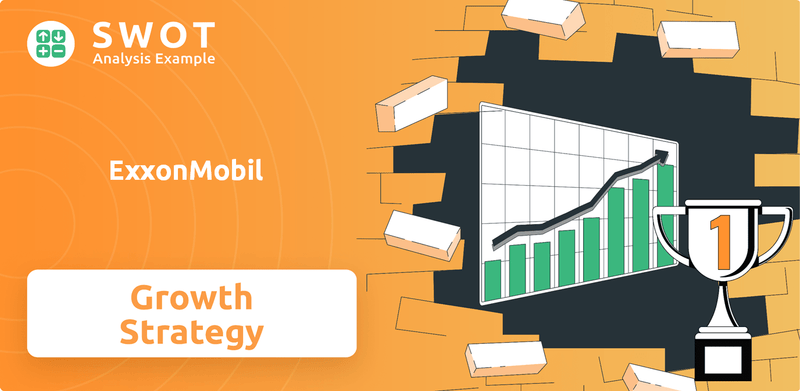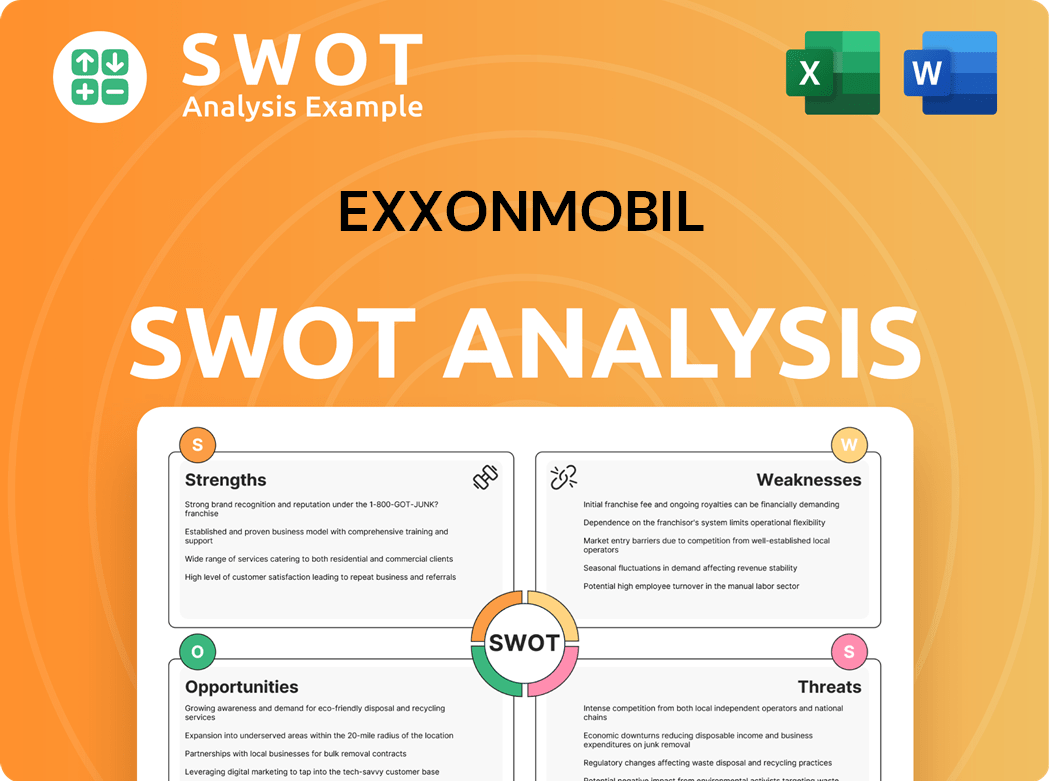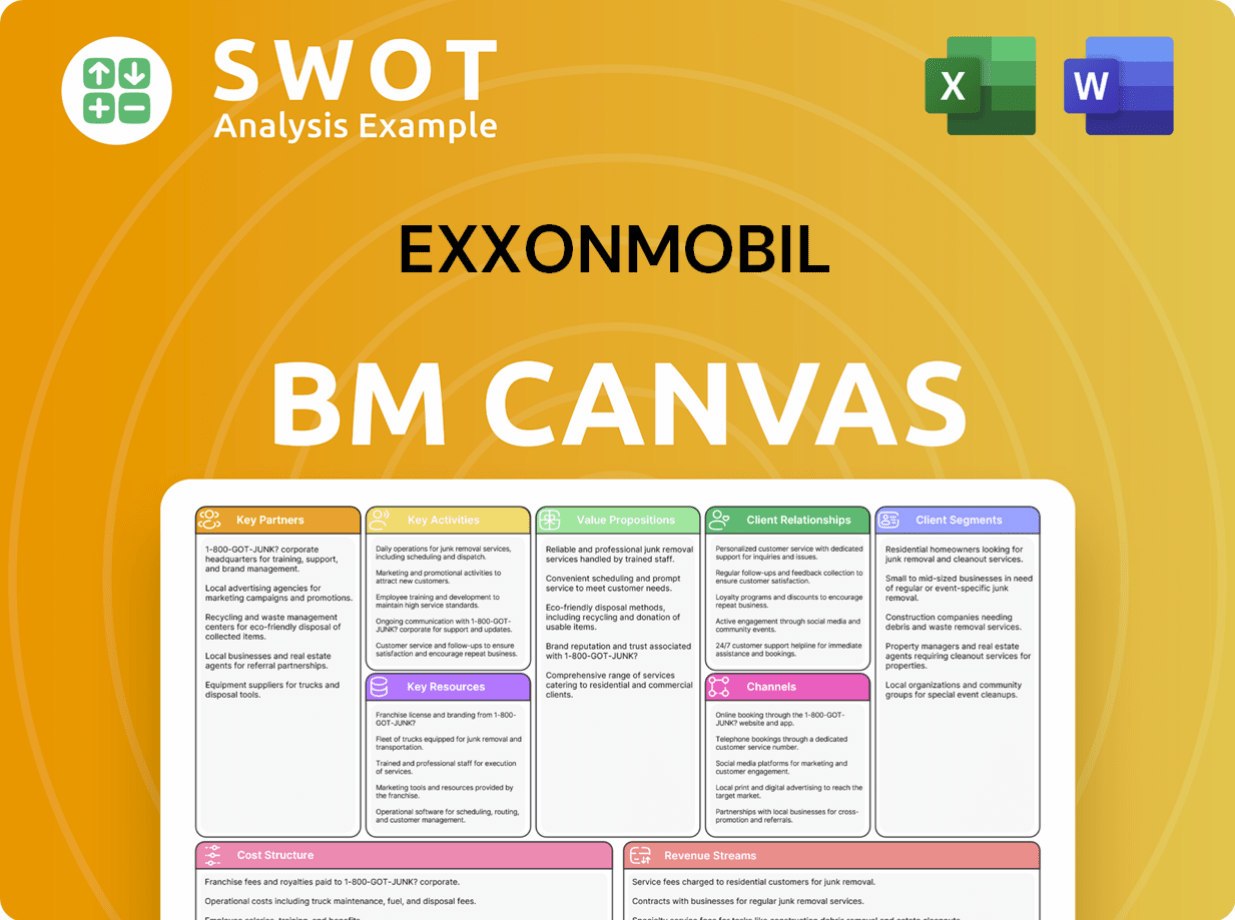ExxonMobil Bundle
Can ExxonMobil Thrive in Tomorrow's Energy Landscape?
As the energy sector undergoes a dramatic transformation, understanding the ExxonMobil SWOT Analysis becomes crucial for investors and strategists alike. This report dives deep into ExxonMobil's growth strategy, examining its ability to adapt and innovate in the face of evolving global energy demands. From its roots in the Standard Oil era to its current status as an industry leader, ExxonMobil's journey offers valuable insights.

This exploration of ExxonMobil's future prospects will analyze its strategic initiatives, including expansion plans and technological advancements within the oil and gas industry. We'll assess the company's financial performance, market share, and long-term growth potential, while also considering the impact of renewable energy and the challenges and opportunities it faces in a rapidly changing environment. This comprehensive ExxonMobil company analysis provides a data-driven perspective for informed decision-making in the energy sector outlook.
How Is ExxonMobil Expanding Its Reach?
The expansion initiatives of ExxonMobil are central to its ExxonMobil growth strategy, focusing on both traditional energy sources and low-carbon solutions. This multi-faceted approach aims to capitalize on current market demands while preparing for future energy transitions. The company's strategic investments and production targets reflect a commitment to long-term growth and sustainability within the oil and gas industry.
ExxonMobil's expansion plans encompass significant investments in upstream production, particularly in key regions like the Permian Basin and Guyana. Simultaneously, the company is allocating substantial resources to develop low-carbon technologies and projects. These dual strategies position ExxonMobil to adapt to evolving market dynamics and regulatory pressures while maintaining its competitive edge in the energy sector outlook.
This comprehensive approach is designed to enhance shareholder value and support global energy needs. The company's strategic initiatives are driven by a commitment to operational excellence, technological innovation, and environmental responsibility, ensuring a balanced approach to growth and sustainability.
ExxonMobil aims to increase its upstream production to 5.4 million barrels of oil-equivalent per day by 2030. Over 60% of this production is expected from advantaged assets, including the Permian Basin, Guyana, and LNG projects. The company achieved its target of having over 50% of its total upstream production from advantaged assets three years ahead of schedule.
The company plans to double its Permian Basin production. In Guyana, output capacity is set to increase to 940,000 barrels per day (bpd) in 2025, up from 616,000 bpd in 2024. The consortium aims to exceed 1.7 million bpd by the end of 2029. These expansions are crucial for ExxonMobil's future prospects.
ExxonMobil is investing up to $30 billion in low-emission opportunities between 2025 and 2030. Approximately 65% of this investment is dedicated to reducing emissions for third-party customers. Key projects include a low-carbon hydrogen facility in Texas and carbon capture infrastructure expansions.
The company aims to reach 1 billion pounds of global recycling capacity by 2027 through its advanced recycling operations in Texas. In Indonesia, ExxonMobil is committed to a $15 billion investment for natural gas development with carbon capture and storage, along with a petrochemical hub.
ExxonMobil's expansion strategy is marked by significant investments in both traditional and low-carbon energy projects. These initiatives are designed to boost production, reduce emissions, and diversify the company's portfolio. The company's performance is influenced by the ExxonMobil market share analysis and its ability to adapt to market changes.
- Permian Basin: Targeting to double production.
- Guyana: Increasing output capacity to 940,000 bpd in 2025.
- Low-Carbon Hydrogen Facility: Expected startup in 2029.
- Carbon Capture: Expanding CCS at the LaBarge, Wyoming facility, starting in 2025.
ExxonMobil SWOT Analysis
- Complete SWOT Breakdown
- Fully Customizable
- Editable in Excel & Word
- Professional Formatting
- Investor-Ready Format

How Does ExxonMobil Invest in Innovation?
The company's growth strategy heavily relies on technological innovation to optimize existing operations and develop new, lower-carbon energy solutions. This approach is crucial for navigating the evolving energy sector outlook and maintaining a competitive edge. The company is actively investing in technologies that support sustainable energy projects and address the challenges and opportunities within the oil and gas industry.
A key aspect of the company's strategy involves expanding its presence in key areas like the Permian Basin, where technological advancements are reshaping operations for enhanced efficiency and production. This strategic focus is designed to boost its long-term growth potential. The company's commitment to innovation is evident in its investments in advanced technologies such as carbon capture and storage, hydrogen production, and advanced recycling initiatives.
The company's commitment to innovation and sustainability is evident in its strategic initiatives, which are designed to drive long-term growth and address evolving energy demands. The company's focus on technological advancements reflects its broader corporate strategy, aiming to maintain its leadership in the energy sector.
The company leverages technology to enhance operational efficiency, particularly in areas like the Permian Basin. Innovations in frac proppant have led to a 15% increase in Estimated Ultimate Recovery (EUR) and a 20% larger fracture area per well. This approach is designed to maximize production and improve financial performance review.
Artificial intelligence (AI) plays a critical role in connecting remote monitoring systems with advanced data analytics. This integration facilitates faster and more informed decision-making across various operations. The use of AI contributes to the company's ability to respond effectively to market dynamics and maintain its market share analysis.
The company is investing heavily in carbon capture and storage (CCS) technology to reduce emissions. A large-scale CCS system is being assembled along the U.S. Gulf Coast. The first U.S. Gulf Coast carbon capture project is expected to start in 2025, capturing up to 2 million tons of CO2 annually.
The company is developing a low-carbon hydrogen and ammonia production facility in Baytown, Texas. This facility is anticipated to capture over 98% of its associated CO2 emissions. This initiative supports the company's long-term growth potential and its transition towards a sustainable energy model.
The company is investing over $200 million to expand its advanced recycling operations in Baytown and Beaumont, Texas. The goal is to reach 1 billion pounds of annual capacity by 2027. The company processed over 70 million pounds of plastic waste since starting its first advanced recycling facility in Baytown in 2022.
These advanced recycling initiatives support a circular economy for plastics by converting hard-to-recycle plastics into raw materials. This effort reflects the company's commitment to sustainability and its proactive approach to addressing environmental concerns. These efforts also contribute to the company's overall business model.
The company's strategic investments in technology and innovation are designed to drive sustained growth and address the evolving energy landscape. These initiatives are key components of the company's long-term strategy, positioning it to capitalize on future opportunities. For a deeper dive into the company's strategic initiatives, you can explore the detailed analysis provided in the article on ExxonMobil's investor relations.
- The company's technological advancements are aimed at improving operational efficiency and reducing environmental impact.
- Investments in CCS, hydrogen production, and advanced recycling demonstrate a commitment to sustainable energy projects.
- The expansion of advanced recycling capacity to 1 billion pounds annually by 2027 highlights the company's dedication to the circular economy.
- AI and data analytics are being integrated to enhance decision-making and optimize resource allocation.
ExxonMobil PESTLE Analysis
- Covers All 6 PESTLE Categories
- No Research Needed – Save Hours of Work
- Built by Experts, Trusted by Consultants
- Instant Download, Ready to Use
- 100% Editable, Fully Customizable

What Is ExxonMobil’s Growth Forecast?
The financial outlook for ExxonMobil is driven by strategic investments and a focus on cost management and shareholder returns. The company's ExxonMobil growth strategy includes significant capital expenditures planned for the coming years. This approach aims to capitalize on opportunities in both traditional and new energy businesses, contributing to its ExxonMobil future prospects.
For the full year 2024, ExxonMobil reported earnings of $33.7 billion, demonstrating strong financial performance. The company generated robust cash flow from operations, reaching $55.0 billion, and free cash flow of $34.4 billion. These figures highlight the company's ability to generate substantial cash, which supports its investment plans and shareholder distributions.
ExxonMobil's strategic focus on cost savings and operational efficiency is a key element of its financial strategy. The company achieved $12.7 billion in cumulative structural cost savings since 2019, including $2.4 billion in 2024. This commitment to cost management enhances profitability and supports the company's ability to invest in growth initiatives and reward shareholders. A comprehensive Marketing Strategy of ExxonMobil also supports the company's financial goals.
ExxonMobil's 2024 financial results showcase strong performance. Earnings reached $33.7 billion, with cash flow from operations at $55.0 billion and free cash flow at $34.4 billion. These figures reflect the company's operational efficiency and strategic investments.
Upstream earnings for 2024 were $25.4 billion, a $4.1 billion increase from 2023. This growth was driven by increased production in Guyana and the Permian Basin, combined with structural cost savings. This demonstrates the success of ExxonMobil's exploration and production strategies.
Chemical Products earnings for 2024 were $2.6 billion, up by $940 million. Specialty Products earnings also increased to $3.1 billion, up by $338 million. These gains reflect improved margins and sales of high-value products.
In 2025, capital expenditures are expected to be between $27 billion and $29 billion. From 2026 to 2030, base capital expenditures are projected to be between $28 billion and $33 billion annually. This will drive ExxonMobil company analysis.
ExxonMobil targets an additional $9 billion in annual Upstream earnings potential by 2030, more than 50% higher than in 2024. This growth will be driven by strategic investments and production increases in key regions.
The company anticipates $8 billion in earnings growth by 2030 from its Product Solutions segment. This expansion is fueled by six advantaged projects across the U.S., UK, Canada, and China, enhancing its market position.
First-quarter 2025 earnings were $7.7 billion, with cash flow from operations at $13.0 billion and free cash flow at $8.8 billion. Despite a slight decline, cost-cutting measures and production growth are expected to offset pressures.
ExxonMobil expects to deliver $18 billion in cumulative structural cost savings through the end of 2030. These savings will improve profitability and support investments in ExxonMobil strategic initiatives 2024 and beyond.
ExxonMobil has increased its annual dividend per share for 42 consecutive years. The company plans for $20 billion in share repurchases annually in 2025 and 2026, assuming reasonable market conditions. This demonstrates a commitment to shareholder value.
The company's capital allocation strategy prioritizes investments in high-return projects, debt reduction, and shareholder distributions. This approach supports long-term growth and enhances financial flexibility, reflecting a robust energy sector outlook.
ExxonMobil Business Model Canvas
- Complete 9-Block Business Model Canvas
- Effortlessly Communicate Your Business Strategy
- Investor-Ready BMC Format
- 100% Editable and Customizable
- Clear and Structured Layout

What Risks Could Slow ExxonMobil’s Growth?
Examining the potential risks and obstacles is crucial when assessing the ExxonMobil growth strategy and its future prospects. The company faces various challenges that could impact its operational and financial performance. A thorough ExxonMobil company analysis must consider these factors to provide a comprehensive understanding of its strategic position.
ExxonMobil operates within the dynamic oil and gas industry, where fluctuations in commodity prices, particularly for natural gas, and refining margins, can significantly affect profitability. Furthermore, regulatory changes and the pace of the energy sector outlook, including the transition to cleaner energy sources, pose significant risks. The company's ability to navigate these risks will be essential for its corporate strategy and long-term success.
ExxonMobil is actively managing a range of strategic and operational risks that could influence its growth trajectory. These risks include market competition, price volatility, and regulatory changes related to climate and emissions, all of which could increase compliance costs. The company also faces technological disruptions and supply chain vulnerabilities, which necessitate proactive risk management and diversification strategies. For further insights into the company's target market, you can explore this article: Target Market of ExxonMobil.
ExxonMobil faces stiff competition in the oil and gas industry, which can impact its market share and profitability. Fluctuations in commodity prices, especially for natural gas, and refining margins pose significant financial risks. In Q1 2025, earnings decreased due to lower refining margins and crude prices, highlighting the sensitivity of the company's financial performance to market conditions.
Regulatory changes and evolving government policies, particularly regarding climate change and emissions, present substantial risks to ExxonMobil. Many countries are implementing regulatory frameworks to reduce greenhouse gas emissions, potentially increasing compliance costs. For example, regulatory challenges in California led to a $2.0 billion impairment in 2023 related to the Santa Ynez Unit assets.
The pace of energy transition and technological advancements are risks to ExxonMobil. While the company is investing in low-carbon solutions, achieving net-zero ambitions by 2050 requires new technologies to reduce costs and increase the scalability of alternative energy sources. The company acknowledges that the policies driving innovation are not advancing fast enough to meet net-zero goals by 2050.
ExxonMobil's large-scale projects and global operations are vulnerable to supply chain disruptions and constraints on skilled labor and materials. Large mergers and acquisitions, like the Pioneer Natural Resources acquisition, face regulatory scrutiny, potentially impacting timelines. The company aims to mitigate these risks through diversification, robust risk management frameworks, and scenario planning.
ExxonMobil's financial performance is closely tied to its ability to manage these risks effectively. The company's upstream production saw strong earnings in 2024, but energy products earnings declined due to weaker industry refining margins. In Q1 2025, earnings reflected a decrease, attributed to lower refining margins and crude prices, impacting ExxonMobil's market share analysis.
ExxonMobil is undertaking ExxonMobil strategic initiatives 2024 to navigate these challenges, including investments in low-carbon solutions and diversification. The company's ExxonMobil expansion plans are subject to regulatory approvals and market conditions. The ExxonMobil stock forecast depends on effectively managing these risks and capitalizing on opportunities within the energy sector outlook.
ExxonMobil faces ExxonMobil challenges and opportunities in the form of market competition, regulatory changes, and technological disruption. The company's ability to adapt and innovate will be crucial for its long-term success. The oil and gas industry is undergoing significant changes, which require ExxonMobil to proactively manage risks and seize opportunities.
ExxonMobil's competitive landscape includes major players in the oil and gas industry, and the company's business model must remain resilient. ExxonMobil must continually assess its position and adapt to changing market dynamics. The company's long-term growth potential depends on its ability to outperform its competitors and maintain a strong market share.
ExxonMobil Porter's Five Forces Analysis
- Covers All 5 Competitive Forces in Detail
- Structured for Consultants, Students, and Founders
- 100% Editable in Microsoft Word & Excel
- Instant Digital Download – Use Immediately
- Compatible with Mac & PC – Fully Unlocked

Related Blogs
- What are Mission Vision & Core Values of ExxonMobil Company?
- What is Competitive Landscape of ExxonMobil Company?
- How Does ExxonMobil Company Work?
- What is Sales and Marketing Strategy of ExxonMobil Company?
- What is Brief History of ExxonMobil Company?
- Who Owns ExxonMobil Company?
- What is Customer Demographics and Target Market of ExxonMobil Company?
Disclaimer
All information, articles, and product details provided on this website are for general informational and educational purposes only. We do not claim any ownership over, nor do we intend to infringe upon, any trademarks, copyrights, logos, brand names, or other intellectual property mentioned or depicted on this site. Such intellectual property remains the property of its respective owners, and any references here are made solely for identification or informational purposes, without implying any affiliation, endorsement, or partnership.
We make no representations or warranties, express or implied, regarding the accuracy, completeness, or suitability of any content or products presented. Nothing on this website should be construed as legal, tax, investment, financial, medical, or other professional advice. In addition, no part of this site—including articles or product references—constitutes a solicitation, recommendation, endorsement, advertisement, or offer to buy or sell any securities, franchises, or other financial instruments, particularly in jurisdictions where such activity would be unlawful.
All content is of a general nature and may not address the specific circumstances of any individual or entity. It is not a substitute for professional advice or services. Any actions you take based on the information provided here are strictly at your own risk. You accept full responsibility for any decisions or outcomes arising from your use of this website and agree to release us from any liability in connection with your use of, or reliance upon, the content or products found herein.